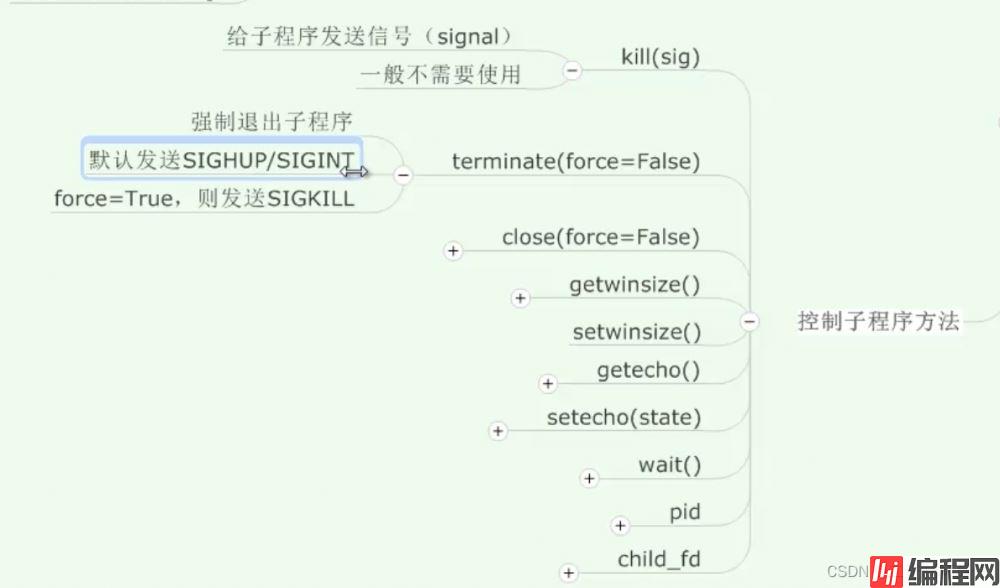Python 官方文档:入门教程 => 点击学习
目录一、pexpect模块介绍二、Pexpect的安装三、pexpect的核心组件3.1spawn类3.1.1简介3.1.2使用流程3.1.4基本属性和方法3.1.5其他发送信息的方
Pexpect使python成为控制其他应用程序的更好工具。可以理解为linux下的expect的Python封装,通过pexpect我们可以实现对ssh,ftp,passwd,telnet等命令行进行自动交互,而无需人工干涉来达到自动化的目的
#python2
pip install pexpect
#python3
pip3 install pexpect3.1.3 构造方法参数
| 参数 | 说明 |
|---|---|
| command | 任何系统可执行的命令 参数可直接放入command 不直接支持管道、通配符、标志输入、输出、错误重定向 |
| args=[] | 专门将command命令的参数放入这个列表中 以 '/bin/bash',['-c','cat test | grep gree']形式实现管道、通配符、标志输入、输出、错误重定向等功能 |
| timeout=30 | 超出时间,抛出错误 |
| maxread=2000 | 从TTY读取信息最大缓冲区 |
| logfile=None | 指定日志文件,可指定为sys.stdout |
| cwd=None | 指定命令运行时的当前目录 |
| env=None | 指定命令运行时环境变量有哪些 |
| encoding=None | 命令运行时,信息编码 |
| codec_errors=‘strict’ | 编码转换时的转向 |
(1)command
>>> import pexpect
>>> child = pexpect.spawn('ls')
>>> child.expect(pexpect.EOF)
0
>>> print(child.before.decode())
get-pip.py nohup.out stop-ssl-dos.sh
index.html Python-2.7.18 ssl_flood.sh
>>> child = pexpect.spawn('ls -l /home')
>>> child.expect(pexpect.EOF)
0
>>> print(child.before.decode())
total 12
drwxr-xr-x 12 root root 4096 Dec 15 14:52 files
drwxr-xr-x 10 root root 4096 Aug 13 2020 opt
drwxr-xr-x 2 root root 4096 Jul 27 2017 users
# 不支持管道、通配符、标志输入、输出、错误重定向
>>> child = pexpect.spawn('ls -l | grep Python')
>>> child.expect(pexpect.EOF)
0
>>> print(child.before.decode())
/bin/ls: cannot access |: No such file or directory
/bin/ls: cannot access grep: No such file or directory
/bin/ls: cannot access Python: No such file or directory
(2)args=[]
# []传入参数列表
>>> child = pexpect.spawn('ls',args=['-l','/home'])
>>> child.expect(pexpect.EOF)
0
>>> print(child.before.decode())
total 12
drwxr-xr-x 12 root root 4096 Dec 15 14:52 files
drwxr-xr-x 10 root root 4096 Aug 13 2020 opt
drwxr-xr-x 2 root root 4096 Jul 27 2017 users
# 实现管道、通配符、标志输入、输出、错误重定向等功能
>>> child = pexpect.spawn('/bin/bash',['-c','ls -al | grep Python'])
>>> child.expect(pexpect.EOF)
0
>>> print(child.before.decode())
drwxr-xr-x 18 1000 1000 4096 Feb 9 20:31 Python-2.7.18
(5)logfile=None
打开文件
>>> f = open('log.txt','wb')
>>> child = pexpect.spawn('ls -l /home', logfile=f)
>>> child.expect(pexpect.EOF)
0
>>> f.close()
>>> exit()
[root@xxxx-2021 ~]# cat log.txt
total 12
drwxr-xr-x 12 root root 4096 Dec 15 14:52 files
drwxr-xr-x 10 root root 4096 Aug 13 2020 opt
drwxr-xr-x 2 root root 4096 Jul 27 2017 users
在终端直接显示
>>> f = open('log.txt','wb')
>>> child = pexpect.spawn('ls -l /home', logfile=f)
>>> child.expect(pexpect.EOF)
0
>>> f.close()
>>> exit()
[root@xxxx-2021 ~]# cat log.txt
total 12
drwxr-xr-x 12 root root 4096 Dec 15 14:52 files
drwxr-xr-x 10 root root 4096 Aug 13 2020 opt
drwxr-xr-x 2 root root 4096 Jul 27 2017 users
(6)cwd=None
>>> child = pexpect.spawnu('ls -al', logfile=sys.stdout, cwd='/home')
>>> child.expect(pexpect.EOF)
total 20
drwxr-xr-x 5 root root 4096 Jul 27 2017 .
drwxr-xr-x 28 root root 4096 Dec 16 07:56 ..
drwxr-xr-x 12 root root 4096 Dec 15 14:52 files
drwxr-xr-x 10 root root 4096 Aug 13 2020 opt
drwxr-xr-x 2 root root 4096 Jul 27 2017 users
0
>>>
| 描述 | 说明 |
|---|---|
| 基本方法 | expect(pattern,timeout=-1)注:仅列出主要参数- pattern:可以为字符串、正则表达式、EOF、TIMEOUT,或者是以上类型的列表。用于匹配子命令返回结果 - 从子命令返回结果中进行匹配,若只提供字符串等非列表,匹配成功返回0;若提供列表,则返回匹配成功的列表序号;匹配失败则会引发异常; - 匹配事项: (1)匹配的方式是从返回信息中逐个字符读出进行匹配 (2)pattern为列表时,从左至右哪个最先匹配到就匹配哪个 (3)可以对结果进行多次匹配,但只能从前往后,前边已搜索匹配的内容不会再进行匹配 (4)匹配时自动应用re.DOTALL正则选项。( .+会匹配所有字符,.*返回空字符)。(5)匹配行尾用 '\r\n'(无法用$匹配行尾)- timeout默认为-1时,使用默认的超时期限;设置为None时,将阻塞至返回信息 sendline(s='') |
| 基本属性 | before:匹配点之前的文本 after:匹配成功的内容 match:已匹配的匹配对象,匹配失败为None |
| 特殊匹配 | pexpect.EOF pexpect.TIMEOUT 它们实际是两个异常类 |
(1)expect()连续匹配
# 连续匹配
>>> child = pexpect.spawn('ls -l')
>>> child.expect(pexpect.EOF)
0
>>> print(child.before)
total 8
-rw-r--r-- 1 root root 0 Feb 21 19:18 log.txt
drwxr-xr-x 2 root root 4096 Feb 21 19:18 test
drwxr-xr-x 2 root root 4096 Feb 21 19:19 tttt
>>>
>>> child = pexpect.spawn('ls -l')
>>> child.expect('test')
0
>>> print(child.after)
test
>>> child.expect('ttt')
0
>>> print(child.after)
ttt
>>>
# 连续匹配 列表形式
>>> child = pexpect.spawn('ls -l')
>>> child.expect('test')
0
>>> print(child.after)
test
>>> child.expect('ttt')
0
>>> print(child.after)
ttt
>>>
>>> child = pexpect.spawn('ls -l')
>>> child.expect('test')
0
>>> child.expect(['test','ttt'])
1 # 1为ttt的列表索引,因为此前已经匹配过test,文件游标不会再匹配(test在前,tttt在后)
>>>
(2)sendline(s=’’)
bash展示
[root@xxxx-2021 ~]# nslookup
> https://www.jd.com/
Server: 10.138.48.2
Address: 10.138.48.2#53
Non-authoritative answer:
*** Can't find Https://www.jd.com/: No answer
>
使用sendline实现以上命令行功能:
>>> import pexpect
>>> child = pexpect.spawn('nslookup')
>>> child.expect('>')
0
>>> child.sendline('https://www.jd.com/')
20
>>> child.expect('>')
0
>>> print(child.before.decode())
https://www.jd.com/
Server: 10.138.48.2
Address: 10.138.48.2#53
Non-authoritative answer:
*** Can't find https://www.jd.com/: No answer
>>>
| 方法 | 描述 |
|---|---|
| send(s) | 类似于sendline(),只发送字符串给子程序; 不添加回车符(换行符); 打开了日志,则会添加到日志中; 返回已发送字节数; |
| write(s) | 同send()方法,但无返回值; |
| writelines(sequense) | 调用write()方法,将序列中内容发送 |
| sendcontrol(char) | 发送类似ctrl+d、ctrl+d等组合键 |
| sendof() | 发送一个结束符,一般用于确认上一次发送内容缓冲结束 |
| sendintr() | 发送退出信号 |
| 方法 | 描述 |
|---|---|
| expect_exact() | 用法与expect()方法相同,匹配速度更快; 除pattern不能用正则表达式 |
| expect_list() | 匹配列表只用已编译正则表达式和EOF、TIMEOUT; 提高匹配速度; expect()方法是通过它工作的 |
| read(size=-1) | 从子程序输出中读取指定量数据。 size为-1时读取时直到EOF(当子程序退出后使用) |
| readline(size=-1) | -1时直接读取一行数据; 0时返回为空; 其他值时被忽略,返回一行; |
# send方法
>>> child = pexpect.spawn('nslookup')
>>> child.expect('>')
0
>>> child.send('www.baidu.com')
13
>>> child.send('\n')
1
>>> child.expect('>')
0
>>> print(child.before.decode())
www.baidu.com
Server: 10.138.48.2
Address: 10.138.48.2#53
Non-authoritative answer:
www.baidu.com canonical name = www.xxx.com.
Name: www.xxx.com
Address: 100.59.200.6
Name: www.xxx.com
Address: 100.59.200.7
# write方法
child.write('www.baidu.com\n')
# writelines方法
child.writelines(['www.baidu.com','\n'])
# sendintr方法 -- False表示子程序已经结束了
>>> child.sendintr()
>>> child.isalive()
False
| 方法 | 描述 |
|---|---|
| compile_pattern_list(patterns) | 编译列表每一项的正则表达式; 当多次应用expect匹配时,每次会先对其列表实行编译后匹配; 为了提高效率,可以预先调用它进行编译; 之后直接使用expect_list()方法进行匹配 |
| eof() | 抛出过EOF错误,则返回真。 |
| interact(escape_character=’\x\d’, input_filter=None, output_filter=None) | 实现子程序和用户直接交互; 开启了日志,输入和输出会记录在日志文件中; input_filter和output_filter用于对输入和输出进行过滤;传入的应是接受字符串参数并返回字符串的一个函数; 默认退出键为 ctrl+] |

| 方法 | 描述 |
|---|---|
| kill(sig) | 通过给子程序发送信号(signal); |
到此这篇关于Python模块之pexpect详解的文章就介绍到这了,更多相关Python模块pexpect 内容请搜索编程网以前的文章或继续浏览下面的相关文章希望大家以后多多支持编程网!
--结束END--
本文标题: Python模块pexpect安装及使用流程
本文链接: https://lsjlt.com/news/140521.html(转载时请注明来源链接)
有问题或投稿请发送至: 邮箱/279061341@qq.com QQ/279061341
2024-03-01
2024-03-01
2024-03-01
2024-02-29
2024-02-29
2024-02-29
2024-02-29
2024-02-29
2024-02-29
2024-02-29
回答
回答
回答
回答
回答
回答
回答
回答
回答
回答
0